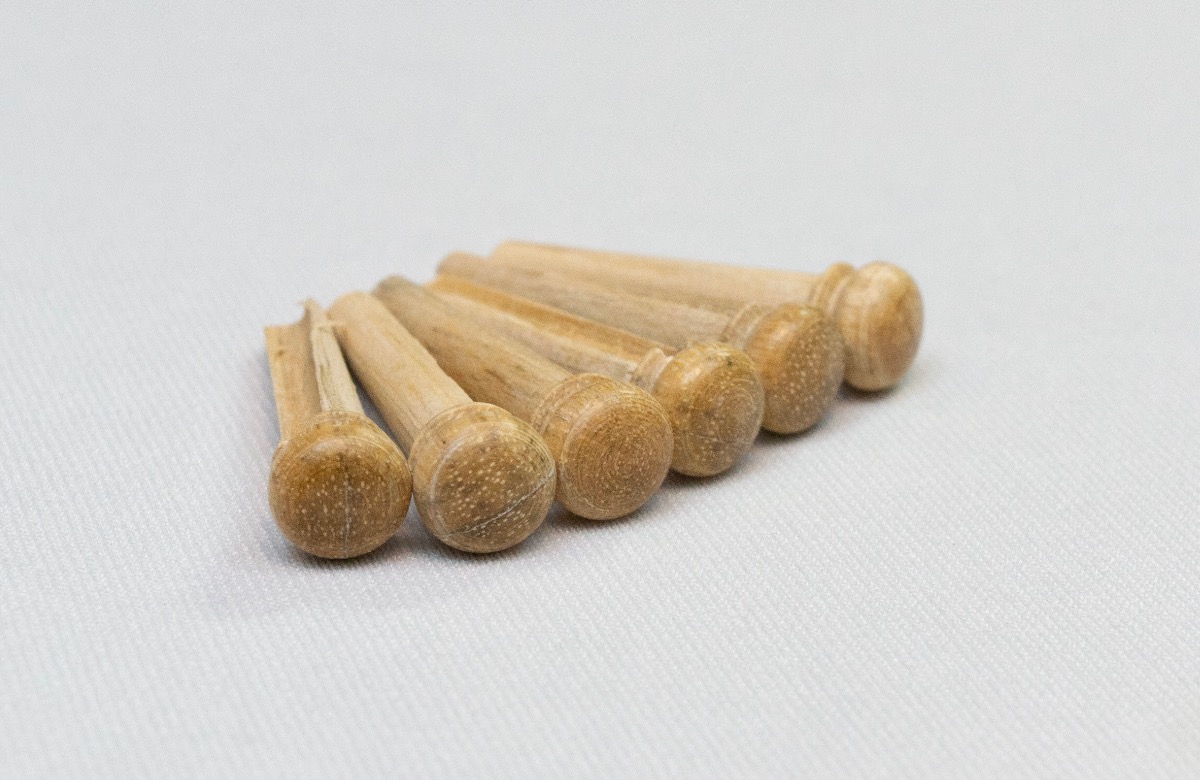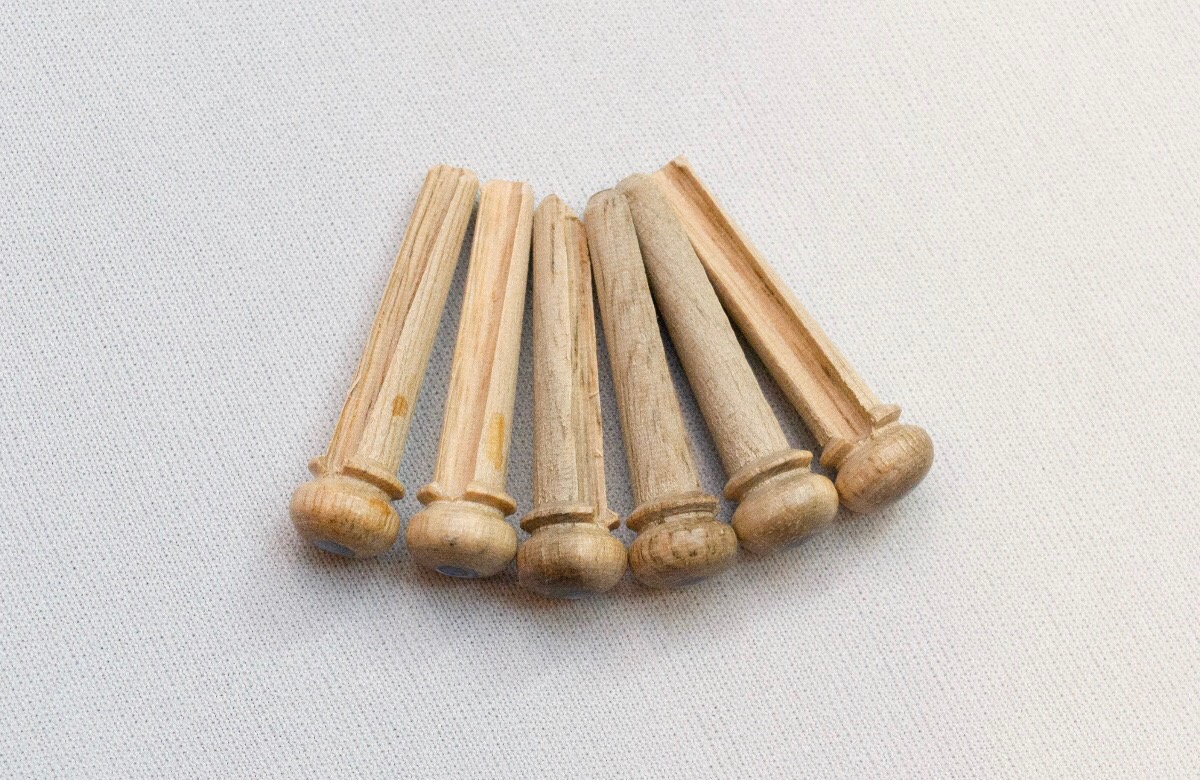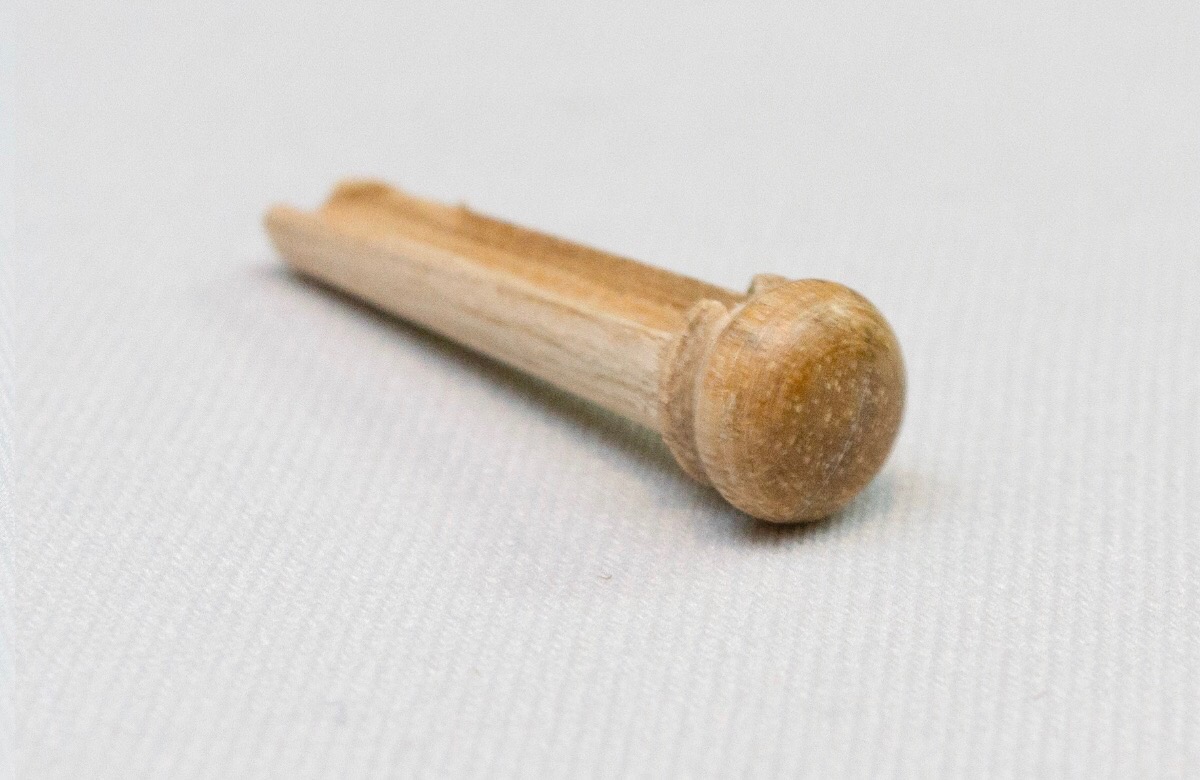Handcrafted to exacting specifications from beautiful solid persimmon wood, these bridge pins add a touch of elegant distinction to any acoustic guitar, in terms of their looks and their tone-enhancing properties. But they are especially recommended for high-end professional-level instruments of rich, complex tone, because of how they heighten the definition of both the fundamental notes and harmonic overtones, while also increasing the sustain of both. Don’t just take our word for it. While we were impressed with the looks of these out of the ordinary bridge pins, we were also intrigued by their potential to influence tone in a unique manner. So, we sent a set of these persimmon bridge pins to our favorite set of ears, connected to the discerning mind of Spoon Phillips. Here is the report Spoon sent from his home in Brooklyn, New York:

I will say right up front, that I was pleasantly surprised that I enjoy these solid persimmon bridge pins so very much. I have tried them on multiple guitars with a variety of string types, and I was unprepared for how they would improve the tone of my primary guitar, the 000C-21 TSP MM that I designed for Maury’s Music. So, I regret to inform you that you cannot have them back!
The shaping of these polished bridge pins is symmetrical and finely detailed, and slotted to work with modern bridges. But they can be inserted backwards to work with vintage guitars that have the slots carved into the bridge itself. But frankly, I assumed they would offer a blonde alternative to darker woods used for bridge pins and end pins, like ebony and rosewood, but otherwise would have the same basic woody influence on tone production. Actually, they are as much a counterpart to ebony pins in terms of sound as they are in terms of looks.
Rather than taking away high end sheen or thickening the voice of a guitar, as ebony pins do, the persimmon bridge pins I was provided bring out much more detail from the guitar’s tonal pallet and harmonic voice than either ebony pins or plastic pins. My primary guitar is a dark, rich, thick-sounding Guatemalan rosewood/Adirondack spruce 000 made with a short-scale neck, scalloped 1/4" OM bracing, hide glue, and vintage-style thin finish. It is abnormally responsive to nuanced playing. These pins increase the definition in ways I simply have not heard from this instrument before now.
When I play bassy chords just on the wound strings, each note is distinct even when swamped by the smoky Guatemalan undertone. Having grown accustomed to how it sounded before these new pins, I was startled by how much more three-dimensional definition could be heard the lowest register.

But I was most surprised by how high harmonics are promoted with astonishing clarity. For example, strumming an open chord where the G and D string are double-stopped at the 5th or 7th fret (Em11 or E7sus, etc.) they produced high overtones from the unwound strings that have the strength and presence of sounded harmonics (i.e. as if another player had played the b and e strings on another guitar while lightly touching the strings at the 5th or 7th fret, to produce harmonics two octaves above the fundamental.)
I had to go back and see if those harmonic sprites could be heard with other pins. They can, but I never noticed them before. They are just so much more pronounced and defined with these persimmon pins. And there is an increased sense of three-dimensional space and depth across the entire voice, and a noticeable presence of a dry and woody quality that went previously undetected, and which I typically associate with older instruments.
I am assuming these persimmon pins are not adding anything to the sound of my guitar. Rather, they are filtering the tone producing energy from the strings in a way that allows details to emerge that have gone unnoticed or have been hidden by the murky broth down inside its voice, which is an inherent part of the rich rosewood sound.
I tried these pins on other guitars as well, with various types of strings. In each case, I took my time, focusing on the sound from a particular string before changing just that one pin, and then seeing how it compared to the other strings, and how it compared to my memory of how that particular string sounded before the change. And I experimented with dampening the other five strings, or letting various sympathetics ignite and sustain along with the played note. I tried these various tests as I was changing pins and after all six pins had been replaced. The difference made by the persimmon pins was obvious and to a greater extent than I thought possible. The results always included greater volume compared to plastic pins, and increased fundamental sustain (the length of time the main note produced by the played string maintains a full and on-pitch tone, before fading or wavering off-pitch). Sustain was at least a full second longer than the same string with a plastic bridge pin. That is a lot of difference when it comes to how long a note stays at peak volume before it starts to decay.
With my 000C-21 TSP the change went from just over 4 seconds to just over 5 seconds. The times are based on certain fretted notes that naturally have good sustain (found at different locations depending on which of the six strings was played, and at different frets for different strings when it comes to triggering sympathetics from other unplayed strings.)

With my 11-year-old OM-42 Deep Body Custom the increase was the same, a full second at least, from just over 5 seconds to just over 6, but the fade lasted longer as well. And on the 25 year old mahogany Martin, a 000C-16 with scalloped OM bracing, the initial fundamental sustain went from over 6 seconds to maybe 8 seconds. And the sustain was not only longer but retained greater definition between the various tones wavering in and around one another as notes or chords were left to ring out. In the case of the mahogany Martin, the pin holes had been slotted by its previous owner, so the persimmon pins were inserted backwards, with the slots facing away from the bridge. But while its
impressive sustain may be related to the slotting of the bridge, I suspect more of it has to do with the particular Sitka spruce soundboard and the fact it has been played a great deal for a quarter of a century.
When it came to the unison or overtone sympathetics, they likewise had extended sustain, but the played note always stayed strong for that extra second before starting its decay down into the overall body resonance. When compared to the plastic pins that come standard with most acoustic guitars, wooden pins tend to add some fundamental sustain. The ebony pins proved to have increased fundamental sustain compared to the plastic pins. But the persimmon pins sustained even longer than the ebony ones. Wooden pins may also add some extra volume, but at the cost of reducing high-end vibrancy and (potentially decreasing) the clarity of high-end harmonic overtones. At least that is case for ebony, and rosewood pins from my previous experience. But these persimmon pins do not just increase basic note volume compared to plastic pins; they actually increase clarity, note separation, and bring out all sorts of little details. Again, this was especially true of the dark and smoky rosewood voice of my 000. The change was like the sonic version of a camera lens getting that last little tweak that brings the visual tableau into marvelous high-definition focus. And this increase in definition was even greater when compared to the ebony pins, which tend to reduce definition.
Now, the effects upon tone by ebony or rosewood pins are not necessarily a bad thing, since they can be of help to guitars that are deemed overly bright, strident, or thin in the tone department. And I know for a fact they can help a brand new bone saddle not sound quite so shrill in its first weeks of getting played in. And the increase and volume and sustain of the persimmon bridge pins wasn’t a lot compared to the ebony pins I had been using. The main difference was in that detail in the voice, no matter what guitar was being tested.
My deep-deep body OM-42 is made from Madagascar rosewood and Adirondack spruce. It is much brighter and vibrant compared to the Guatemalan rosewood 000. It has bone pins as well, which only serve to increase both brightness and string vibrancy. But while this may seem like the power of suggestion, I must say that the persimmon bridge pins made all my guitars sound woodier, somehow.
There is what I like to call the “old wooden box” sound to old guitars, which can be heard to some extent in modern guitars with Adirondack spruce tops. Well, I would not say I heard much of it in that OM-42 before now, and it never came to mind where my 000 is concerned. But both of these rosewood guitars had that dry, reflective Adi sound down in the undertone when using these new pins. It is not a dominant trait that suddenly appeared. But it is there when I hadn’t noticed much or any of it previously.
And in general the greater definition in the notes, which allows various tones to be heard distinctly from other tones, helps promote a sense of space and openness down inside a guitar’s voice that may have always been there, but it was much more noticeable. The smoky rosewood undertone might be more translucent, or each facet/strata/overtone has greater focus and clarity. The added “woody” sound and suggestion of open space gave both rosewood instruments a more old-timey or, dare I say it, vintage guitar quality, because they are attributes I associate with older guitars. Now it is important to state that I was focused on paying attention to the smallest changes. Many of these attributes were quite subtle, compared to the tonal differences that can be caused by tonewood species, top wood species, saddle material, and so on. But when I would focus on the details, the influence of these pins was greater than I ever expected. And in the case of my Guatemalan/Adirondack 000 they almost made the instrument sound like a whole new guitar! Going back to plastic makes everything seem dull by comparison. So, these pins are staying with this 000C-21 TSP MM, thank you very much, Maury!

The one aspect that might be said to be a reduction in score, compared to plastic or bone pins, comes with playing the guitar with a great deal of force. A heavy attack with a flat pick does not produce as full a punch or as projecting a pop from the strings. The fundamental notes sound less fat or solid, particularly where the unwound treble strings are concerned. This seems to be related to the fact the pins are made out of wood. Ebony is some 15 to 30 percent denser than persimmon, which has the same density of East Indian rosewood, and the ebony pins still responded to hard playing in a similar manner.
That being said, I spent a three-hour rehearsal banging out Django Reinhardt and Fats Waller tunes with the Paul Ukena Trio just yesterday, and the pop and punch of the strings was more than acceptable, even if less than what the plastic pins had previously provided. The difference in 3D inner space, fundamental definition, and harmonic clarity is a very fair trade off a little less muscle during overdrive. I would certainly recommend these persimmon bridge pins to anyone wanting to increase the definition and detail of their guitar’s voice without adding the extra brightness and brilliance that bone pins achieve. But I particularly recommend them for overtone-rich guitars with a lot of chocolatey darkness in the lower registers, like those made with back and sides of Indian or Guatemalan rosewood, cocobolo, African blackwood, or Macassar ebony, and especially for guitarists that play with a light, nuanced touch and want as hear as much harmonic detail as possible.
-TSP, nyc
P.S. The strings used for these tests included Martin Authentic Acoustic Silked 80/20s, for the Guatemalan rosewood 000; Martin Authentic Acoustic phosphor bronze for the Madagascar rosewood OM-42 DB; and the mahogany 000C-16 was tested with Martin Retro Monel strings and Martin Authentic Acoustic phosphor bronze strings.